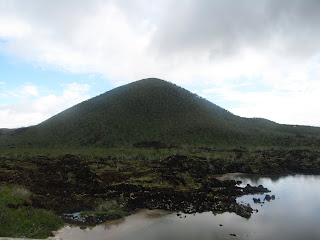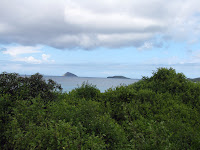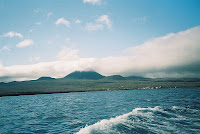 |
| Sorting the Mail at the Post Office on Floreana Island |
Post Office Bay and Floreana Post Office
 |
| Evidence of Previous Visitors to the Post Office |
Floreana, one of the oldest of the Galapagos Islands, and first settled in 1832, is named after Juan Jose Flores, the first president of Ecuador. Now, it is best known for the post office located at Post Office Bay, a brown sand beach inhabited by the ever-present Galapagos sea lions lounging in the sun. For nearly 2 ½ centuries – since 1793 – this unique Galapagos Island post office has been operating in the same fashion. Bring your mail and drop it off, addressed to go anywhere in the world. (On a cruise, your guide will likely provide you with brightly-colored post cards of indigenous animals for this purpose). Then, it’s your job to take a look through the mail that has been left by earlier visitors. If you come across a letter you are able to hand-deliver or mail to someone from your home town, you become the personal mail carrier. Hopefully, someone else will soon come along to carry your mail to your friend or family in the same way. It’s as easy as that.
I’ve known mail to be delivered to obscure places in Australia in as little as a week using this system. On the other hand, your mail could languish – it’s all in the luck of who comes next. The system has been operating for centuries and has been used successfully by pirates, whalers, explorers and visitors. Evidence of early visitors remains at this location.
 |
Getting Wet is Part of Spelunking
in Floreana's Caves |
Just a few meters behind the site of the post office is a cave with rickety steps and ropes as hand holds. It's not a site for the wary and only a few lucky travelers even get to hike into the underground caves that might once have been inhabited by pirates. At least my groups think that they are lucky to have this adventure - until they find themselves submerged to their waists in cold water. Still, it's always an unanticipated and happy highlight of a trip to Floreana when we are able to take this detour.
Punta Cormorant
 |
| The Landscape on Floreana Island |
 |
| Punta Cormorant |
While Post Office Bay is the best known of Floreana’s attractions, it certainly is not the only one. You may have a wet landing at Punta Cormorant, a dark-sand beach formed by the erosion of coral skeletons and olivine crystals. The sand varies in color from greenish to black and glistens in the sun. The crystal-like formations of magnesium, iron and silica have blown to the beach from the top of the tuff cones that form the island’s surface.
 |
View of the Lagoon on a
Cloudy Afternoon - and it's still
stunningly beautiful |
 |
| Flamingos in Salt Water Lagoon |
From here a 720 meter trail leads up and across the island passing a saline-water lagoon before ending at a gorgeous white-sand beach surrounded by dark black volcanic rock. The lagoon is populated by beautiful flamingos, pintail ducks, stilts and other wading birds. Some days the flamingos are huddled in brightly-colored groups; other days may reveal just one lone example. Whether you are treated to one or many, the sight of a flamingo in its natural habitat is a photographer’s dream.
 |
| Prolific Rays on Flour Beach |
But, the trail doesn’t end there and more scenery awaits. The trail ends
at so-called “Flour Beach” named because of its pure and soft white
sand. Flour Beach is the home to nesting green sea turtles and many
rays.
 |
The View of Champion Islet and Pyramid Rock
from Flour Beach on Floreana |
The view from Flour Beach is of Champion Islet and Pyramid Rock, other equally interesting islands and volcanic land masses. The contrast of colors, textures and wildlife on this one small island can be told only in the many photographs you will be sure to take.
 |
| Lava Lizard on Floreana |
 |
| Small Snail on the Rocky Soil on Floreana |
 |
| Indigenous Trees on Floreana |
 |
The Magnificent Vista from the Top of the Trail
Between Cormorant Point and Flour Beach |
 |
| Bird Life on Floreana Blending into the Environment |
Devil's Crown
 |
| Devil's Crown From the Ocean Spray Catamaran |
 |
| A Galapagos Penguin Greets Us |
Floreana is also the home of many scuba diving sites and several excellent snorkeling sites, the best known of which is Devil’s Crown. There is no landing on Devil’s Crown, which is an unusual underwater volcanic formation that quite literally looks like a crown jutting out of the ocean's surface. This submerged volcano has been transformed and eroded by the ocean into a series of jagged peaks. Both the bird and marine life here is quite lush. Encountering Nazca Boobies, pelicans, Red-billed tropic birds and frigate birds is typical. Less likely, but possible, is that you will see the endangered Floreana Mockingbird. Here too you might get to swim with sea lions, white-tipped reef sharks, Galapagos Penguins, sea turtles and many species of tropical fish.
Additional Floreana Visitor Sites
 |
Asilo de la Paz
Photograph from National Park Service |
The Galapagos National Park Service lists additional visitor sites on Floreana as follows, but they are generally not on a cruise ship’s itinerary:
 |
Caves at Asilo de la Paz
Photograph from National Park Service |
Asilo de la Paz: This is a 450 meter hill in the center of the agricultural area of Floreana, and is best known for its series of what are believed to have been pirate caves and a freshwater spring, neither of which are accessible. However, this is, notably, the source of fresh water for the island’s approximately 100 human inhabitants. Nearby is a nesting area for the Galapagos Petrel and a corral built by the National Park Service for housing endangered Galapagos tortoises.
 |
Cerro Alieri
Photograph from National Park Service |
Cerro Alieri: This is a ride and a walk to an altitude of 340 meters and suggested only for those really interested in the indigenous vegetation. The National Park Service calculates that of the 48 species it has identified at this location, 56% are native and 33% are endemic. The Cratericola Linum plant is a species that is critically endangered; only 40 individuals have been found, and they have not yet regenerated. This flora was believed extinct until 1997, when GNP and CDRS personnel rediscovered it.
 |
Mirador de la Baronesa
Photograph from National Park Service |
Mirador de la Baronesa: The hike to the top promises a beautiful panoramic vista of the coastline from the Enderby Islet to Post Office Bay, as well as Cerro Pajas, the pool of flamingos (Punta Cormorant), and an extensive forest of Palo Santo trees. On your panga ride to the site, be prepared for visits from golden eagle rays, sea lions, sea turtles, mullets and even some Galapagos penquins. This is also an excellent spot for taking a panga ride through the red mangrove swamps. The red mangrove is characterized by a hanging elongated fruit, which in reality is a new daughter plant that grows from the parent plant, a rarity in the plant kingdom. The red mangrove is a pioneer in the coasts and has a very hard and resistant wood.
 |
| Floreana from Wiki Commons |
Snorkeling and scuba diving sites, in addition to Devil’s Crown, around Floreana include Caldwell Island, Islote Champion, Islote Enderby, Islote Gardner and Islote Watson.





















No comments:
Post a Comment